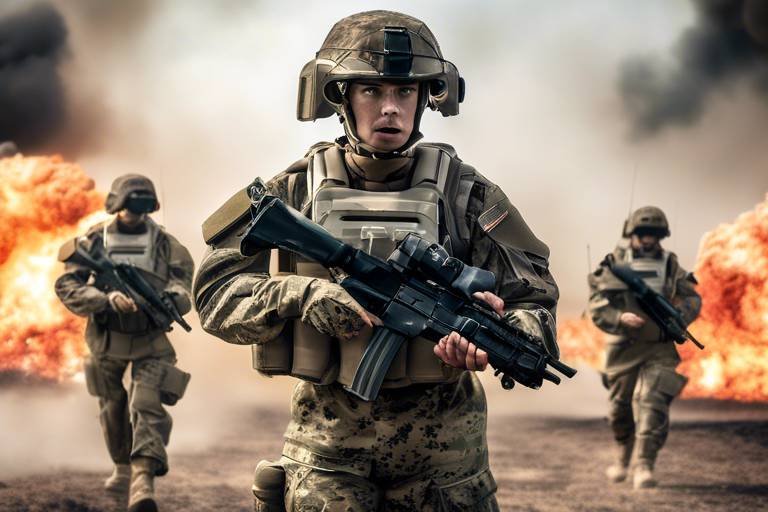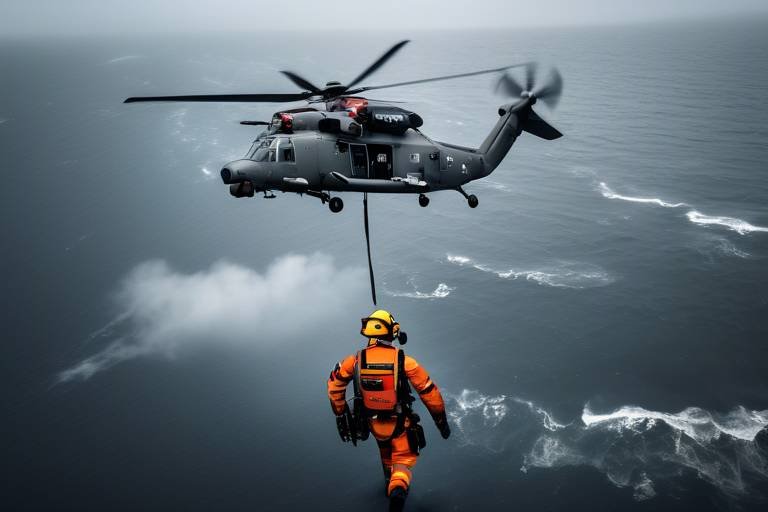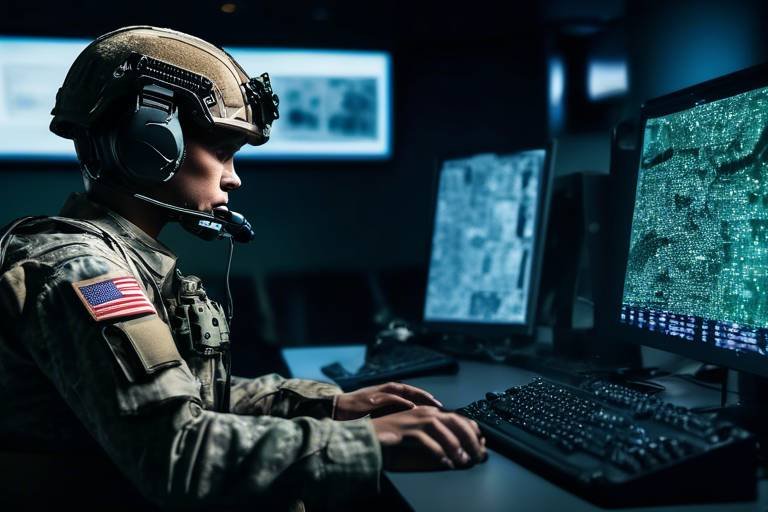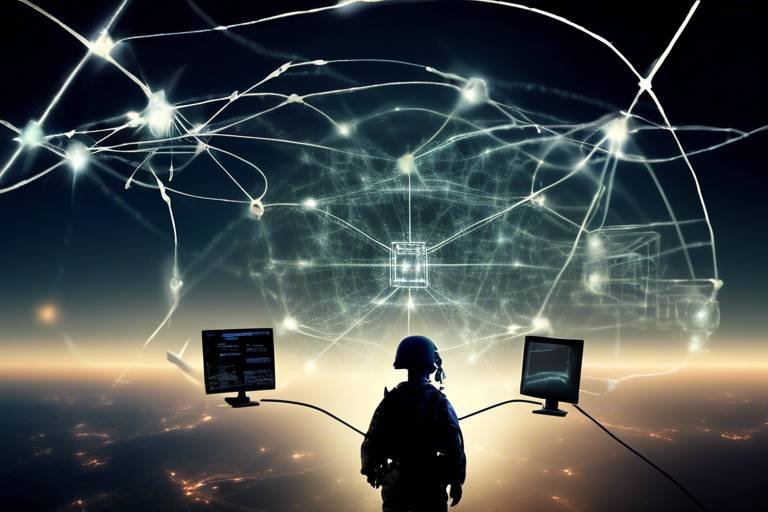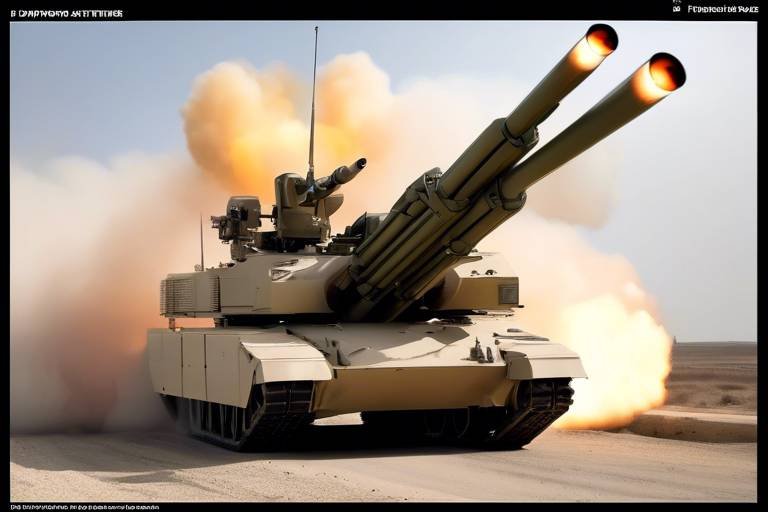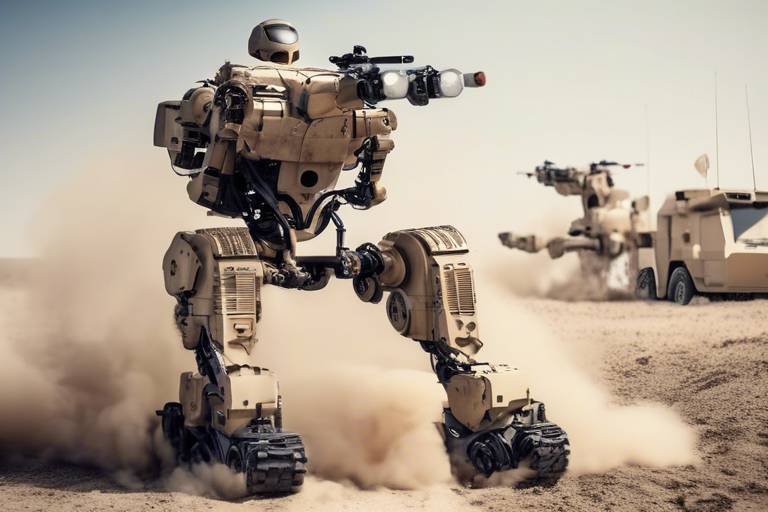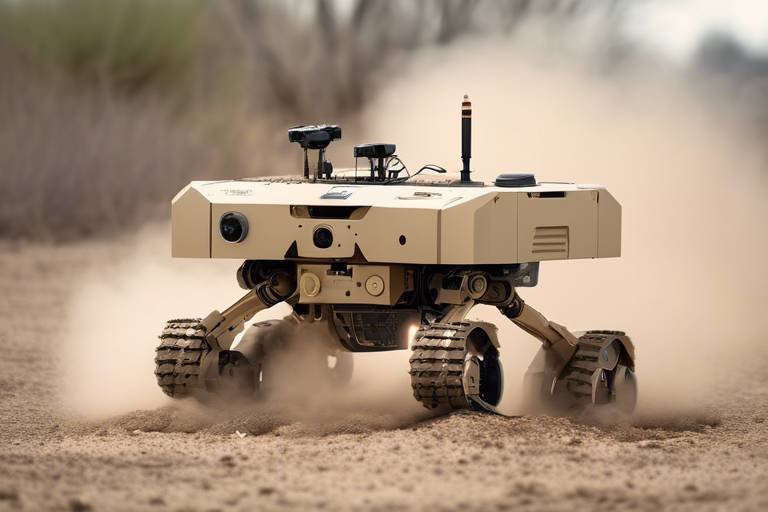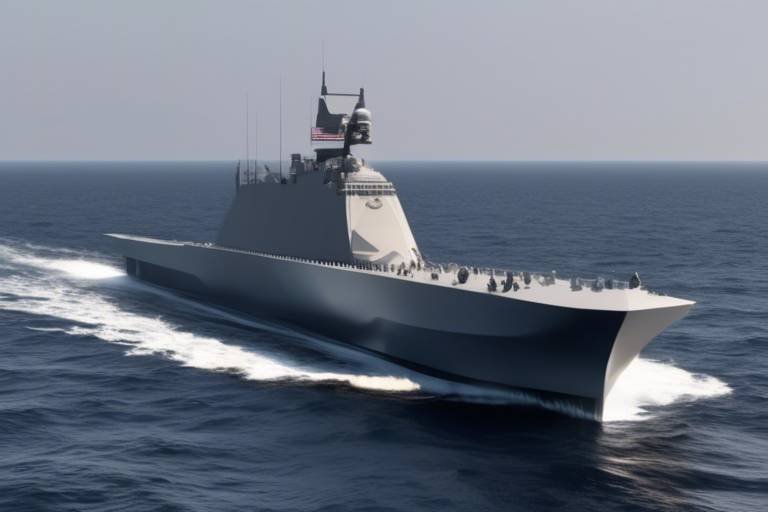The Importance of Secure Communication Systems in Warfare
In the fast-paced and unpredictable realm of modern warfare, secure communication systems play a critical role. Imagine a battlefield where every command, every piece of intelligence, and every strategic maneuver is at risk of interception. The stakes are incredibly high, and the consequences of compromised communication can be catastrophic. This is where secure communication systems come into play, acting as the backbone of military operations. They not only ensure that sensitive information remains confidential but also enhance the operational efficiency of military units. In essence, secure communication is not just a tool; it is a lifeline that can determine the success or failure of a mission.
Secure communication systems encompass a range of technologies designed to protect information from unauthorized access. They enable forces to coordinate effectively, making real-time decisions that can change the course of an operation. Think of it as a well-oiled machine: each part must function seamlessly to ensure the entire system operates at peak performance. When communication lines are secure, military leaders can focus on strategy and execution rather than worrying about potential leaks or breaches. This peace of mind allows for a more dynamic and responsive approach to warfare.
Moreover, the importance of secure communication systems extends beyond just the battlefield. With the rise of cyber warfare, the need for robust communication channels has never been more pressing. Adversaries are increasingly utilizing advanced technologies to disrupt military operations, making it essential for armed forces to stay ahead of the curve. By investing in secure communication systems, military organizations can safeguard their operations against these evolving threats. In a world where information is power, protecting that information is paramount.
As we delve deeper into the various types of secure communication systems and their specific roles, it's crucial to recognize that the future of warfare will continue to evolve. Innovations in technology, such as artificial intelligence and quantum encryption, are on the horizon, promising to further enhance the security and efficiency of military communications. The question remains: are we prepared to adapt to these changes? The answer lies in our commitment to developing and implementing cutting-edge secure communication systems that can withstand the challenges of tomorrow.
- Why are secure communication systems crucial in warfare?
Secure communication systems are essential to protect sensitive information, ensure operational efficiency, and maintain the element of surprise against adversaries. - What types of secure communication systems are used?
Common systems include encrypted radios, satellite communications, and secure messaging applications, each serving unique functions in military operations. - How does cybersecurity impact military communications?
Cybersecurity measures are vital to protect military communications from hacking and data breaches, ensuring that sensitive information remains confidential. - What advancements can we expect in secure military communication?
Future advancements may include technologies like artificial intelligence and quantum encryption, which promise to enhance the security and efficiency of communication systems.

The Role of Communication in Military Strategy
This article explores the critical role of secure communication systems in modern warfare, emphasizing their impact on strategy, operational efficiency, and the safeguarding of sensitive information.
Effective communication is the backbone of military strategy. Imagine trying to orchestrate a complex dance with multiple partners without clear signals—chaotic, right? In warfare, the stakes are even higher. Communication enables the seamless coordination among units, ensuring that commands are executed promptly and accurately during operations. Without it, even the most well-planned strategies can crumble into chaos, leading to disastrous outcomes.
Consider a scenario where a battalion is engaged in a high-stakes operation. The commanding officer must relay real-time information to various units scattered across the battlefield. If there’s a communication breakdown, troops may not receive critical updates about enemy movements or changes in mission objectives. This lack of information can result in misalignment, confusion, and ultimately, mission failure. Thus, communication is not just a tool; it’s a strategic asset.
Moreover, the nature of military communication has evolved dramatically with technological advancements. Today's military relies on a variety of platforms—ranging from encrypted radios to satellite communications—each designed to ensure that information flows smoothly and securely. These systems help maintain operational security, allowing commanders to make informed decisions based on accurate and timely information.
There are several key aspects that highlight the importance of communication in military strategy:
- Real-Time Decision Making: Commanders can make quick decisions based on the most current information available.
- Coordination of Forces: Different units can work together effectively, ensuring that everyone is on the same page.
- Adaptability: Communication allows for rapid adjustments to plans in response to changing battlefield conditions.
In essence, effective communication is akin to the nervous system of a military operation, transmitting vital signals that keep the entire body functioning. The absence of secure communication systems can lead to vulnerabilities that adversaries can exploit, making it crucial for military operations to prioritize and invest in these technologies. In a world where information is power, the ability to communicate securely and efficiently can be the difference between victory and defeat.
Various secure communication systems are employed in warfare, including encrypted radios, satellite communications, and secure messaging apps, each serving distinct purposes in maintaining operational security.
Encrypted radio systems provide secure voice communication, allowing troops to transmit information without interception, ensuring that tactical plans remain confidential and protected from adversaries.
The use of encrypted radios enhances operational security, reduces the risk of eavesdropping, and improves command and control during missions, making them indispensable in modern military operations.
Despite their advantages, encrypted radio systems face challenges such as technical failures, user training requirements, and potential vulnerabilities that could be exploited by sophisticated adversaries.
Satellite communication technologies facilitate long-range communication, enabling real-time data exchange and coordination between ground forces and command centers, crucial for successful military operations.
Cybersecurity is paramount in securing military communications against hacking and data breaches, ensuring that sensitive information remains protected from hostile entities.
Understanding the various threats to communication security, including cyberattacks and electronic warfare, is essential for developing robust defense strategies to protect military communications.
Implementing best practices for cybersecurity, such as regular system updates, employee training, and incident response plans, is critical for maintaining the integrity of military communication systems.
The future of secure military communication involves advancements in technology, including artificial intelligence and quantum encryption, promising to enhance security and efficiency in warfare communication systems.
- Why is secure communication critical in warfare?
Secure communication is essential to protect sensitive information and ensure that military strategies are executed without interception by adversaries.
- What are the main types of secure communication systems used in the military?
The military uses various systems, including encrypted radios, satellite communications, and secure messaging applications, each tailored to specific operational needs.
- How does cybersecurity impact military communications?
Cybersecurity protects military communication systems from hacking and data breaches, ensuring that vital information remains confidential and secure.

Types of Secure Communication Systems
In the ever-evolving landscape of modern warfare, the significance of secure communication systems cannot be overstated. These systems serve as the backbone of military operations, ensuring that vital information flows seamlessly and securely between units. Various types of secure communication systems are employed to meet the unique demands of military engagements, each designed with specific functionalities in mind. From encrypted radios that provide secure voice communication to satellite communication technologies that enable long-range data exchange, the arsenal of secure communication tools is diverse and highly specialized.
One of the most widely recognized types of secure communication systems is the encrypted radio system. These systems are engineered to provide secure voice communication, allowing troops to transmit information without the risk of interception. Imagine a bustling battlefield where every second counts; encrypted radios ensure that tactical plans remain confidential and protected from prying eyes. This is crucial because the consequences of intercepted communication can be catastrophic, potentially leading to mission failure or loss of life.
In addition to encrypted radios, satellite communication technologies play a pivotal role in maintaining secure communication over vast distances. These systems facilitate real-time data exchange and coordination between ground forces and command centers, which is essential for the success of military operations. The ability to communicate instantly, regardless of geographical barriers, provides a significant tactical advantage. With satellite communications, military leaders can make informed decisions based on real-time updates from the field, ensuring that operations are executed with precision.
Moreover, the rise of secure messaging applications has transformed how military personnel communicate. These applications often utilize end-to-end encryption, ensuring that messages remain private and secure from unauthorized access. The convenience of mobile communication combined with robust security features makes these apps an attractive option for modern military operations. However, it's essential to ensure that all personnel are trained to use these applications effectively, as even the most secure system can be compromised by human error.
To summarize, the types of secure communication systems used in warfare include:
- Encrypted Radio Systems: For secure voice communication.
- Satellite Communication Technologies: For long-range and real-time data exchange.
- Secure Messaging Applications: For encrypted text-based communication.
Each of these systems plays a critical role in ensuring operational security, enhancing command and control during missions, and ultimately contributing to the success of military objectives. As technology advances, the evolution of these secure communication systems will continue to shape the future of warfare, making it imperative for military organizations to stay ahead of the curve.
- What are the main types of secure communication systems used in warfare?
The main types include encrypted radio systems, satellite communication technologies, and secure messaging applications. - Why is secure communication important in military operations?
Secure communication is vital to protect sensitive information, ensure operational efficiency, and enhance coordination among units. - How do encrypted radios work?
Encrypted radios use algorithms to scramble voice data, making it unintelligible to anyone without the proper decryption key. - What challenges do military communication systems face?
Challenges include technical failures, the need for user training, and potential vulnerabilities to cyberattacks.

Encrypted Radio Systems
In the ever-evolving landscape of modern warfare, have emerged as a cornerstone of secure communication. These systems are not just tools; they are lifelines that connect soldiers on the ground to their command centers, ensuring that vital information flows seamlessly without the risk of interception. Imagine a battlefield where every whispered command or strategic plan is vulnerable to enemy ears—this is where encrypted radios step in to protect the integrity of military operations.
Encrypted radio systems utilize sophisticated algorithms to scramble voice communications, making it nearly impossible for unauthorized listeners to decipher the messages being transmitted. This ensures that tactical plans remain confidential and protected from adversaries who might be lurking nearby, ready to exploit any weakness. The importance of these systems cannot be overstated, especially when you consider that the success of military operations often hinges on the ability to communicate securely and effectively.
One of the primary advantages of encrypted radios is their ability to enhance operational security. By reducing the risk of eavesdropping, these systems allow military personnel to discuss sensitive information with confidence. Additionally, they improve command and control during missions, facilitating quick decision-making and coordination among units. In a world where milliseconds can mean the difference between success and failure, having a reliable, secure communication system is indispensable.
However, the implementation of encrypted radio systems is not without its challenges. For instance, technical failures can occur, rendering the system inoperable at critical moments. Furthermore, user training is essential to ensure that all personnel are proficient in using these systems. If soldiers are not well-versed in the technology, the very systems designed to protect them can become liabilities. There is also the looming threat of sophisticated adversaries who might seek to exploit potential vulnerabilities within these systems.
Despite these challenges, the benefits of encrypted radio systems far outweigh the drawbacks. As technology continues to advance, we can expect even more robust and resilient communication solutions to emerge. The future of military communication is bright, and encrypted radios will undoubtedly play a pivotal role in shaping the battlefield of tomorrow.

Advantages of Encrypted Radios
Encrypted radios are a cornerstone of modern military communication, providing a level of security that is absolutely essential on the battlefield. Imagine being in the heat of a military operation, where every second counts, and the success of your mission hinges on the ability to communicate without the fear of interception. This is where encrypted radios shine. They offer several key advantages that enhance operational effectiveness and protect sensitive information.
First and foremost, the most significant benefit of encrypted radios is their ability to ensure confidentiality. By encrypting voice communications, these systems prevent adversaries from eavesdropping on tactical discussions. This means that plans, strategies, and movements remain within the confines of the intended units, significantly reducing the risk of compromise. In an era where information is power, maintaining the secrecy of communications can be the difference between victory and defeat.
Moreover, encrypted radios enhance command and control. During operations, commanders need to relay instructions to their troops swiftly and accurately. Encrypted systems facilitate this by allowing real-time communication that is both secure and reliable. Troops can receive updates on changing situations without the delay that can occur with less secure forms of communication. This immediacy can be crucial in dynamic environments where conditions can change in an instant.
Another notable advantage is the reduction of eavesdropping risks. Traditional radio communications can be intercepted with relative ease, especially by technologically advanced foes. However, with encrypted radios, even if an enemy is able to capture the transmission, the information remains unintelligible without the proper decryption keys. This added layer of security is vital in safeguarding operational integrity.
In addition to these operational benefits, encrypted radios also promote interoperability among different branches of the military. With various units often working together, having a secure means of communication that can be utilized across platforms is critical. Encrypted systems can be designed to be compatible with both ground and air units, ensuring that everyone is on the same page, literally and figuratively.
However, it is important to note that the implementation of encrypted radio systems does come with its challenges. For instance, the need for user training cannot be overstated. Troops must be well-versed in operating these systems to maximize their benefits. Additionally, potential technical failures can pose risks if not properly managed. Nevertheless, the advantages far outweigh these challenges, making encrypted radios an indispensable tool in modern warfare.
In summary, the advantages of encrypted radios extend beyond mere communication; they are vital for maintaining the element of surprise, ensuring operational security, and facilitating effective command and control. As military operations become increasingly complex, the reliance on secure communication systems like encrypted radios will only continue to grow.
- What are encrypted radios? Encrypted radios are communication devices that use encryption to secure voice transmissions, preventing unauthorized access and eavesdropping.
- How do encrypted radios enhance military operations? They provide secure, real-time communication that is essential for effective command and control, ensuring that tactical plans remain confidential.
- What challenges are associated with encrypted radios? Challenges include the need for user training, potential technical failures, and the requirement for ongoing maintenance to ensure security.
- Are encrypted radios compatible with other communication systems? Yes, many encrypted radios are designed to be interoperable across different military branches and platforms.

Challenges of Implementation
Implementing encrypted radio systems in military operations is not without its hurdles. While these systems are designed to enhance security and operational efficiency, several challenges can impede their effectiveness. One of the primary issues is the potential for technical failures. Just imagine being on the battlefield, relying on your communication system to relay critical information, only to discover that it has malfunctioned. Such failures can lead to miscommunication, delayed responses, and even jeopardize the success of a mission.
Another significant challenge is the training requirements for personnel. Encrypted radio systems often come with complex interfaces and functionalities that demand thorough understanding and proficiency. It’s not just about pressing a button; operators need to be well-versed in the system's capabilities and limitations. This means investing time and resources into training programs, which can be challenging in a fast-paced military environment where every minute counts. Without adequate training, the risk of user error increases, potentially compromising the very security that these systems are meant to provide.
Moreover, as technology advances, the threat landscape evolves. Even the most sophisticated encrypted systems can have vulnerabilities that can be exploited by savvy adversaries. Cybersecurity threats are ever-present, and military units must stay one step ahead to protect their communication channels. This requires continuous updates and patches, alongside a proactive approach to cybersecurity that can be resource-intensive. The challenge lies in balancing the need for security with the operational demands of military engagements.
To put it simply, the implementation of encrypted radio systems is a double-edged sword. While they offer enhanced security, the challenges of technical failures, the need for extensive training, and the ever-present threat of cyber vulnerabilities cannot be overlooked. Addressing these challenges requires a multifaceted approach, combining technology, training, and robust cybersecurity measures to ensure that military communications remain secure and effective.
- What are encrypted radio systems? Encrypted radio systems are communication devices that use encryption to secure voice and data transmissions, preventing unauthorized access or interception.
- Why is training important for using encrypted radios? Proper training ensures that personnel can effectively operate the systems, minimizing the risk of user errors that could lead to mission failure.
- What are the common vulnerabilities of encrypted communication systems? Common vulnerabilities include software bugs, outdated systems, and the potential for sophisticated cyberattacks that target communication channels.
- How can military units enhance the security of their communications? By implementing regular system updates, conducting comprehensive training, and developing incident response plans to address potential breaches.

Satellite Communication Technologies
In the realm of modern warfare, have emerged as a game-changer, facilitating seamless and reliable communication over vast distances. Imagine trying to coordinate a military operation across multiple terrains and time zones without a solid communication backbone—it's like trying to navigate a ship through a storm without a compass. The ability to communicate in real-time is not just a convenience; it’s a necessity that can mean the difference between success and failure on the battlefield.
Satellite communication systems enable military forces to maintain contact with command centers and other units, even in the most remote locations. This technology allows for the transmission of voice, data, and video, ensuring that critical information flows freely and securely. The integration of satellite systems into military operations has revolutionized how commands are issued and executed. For instance, during complex operations, commanders can monitor troop movements and adjust strategies on the fly, akin to a chess player anticipating an opponent's moves.
One of the standout features of satellite communication technologies is their ability to provide global coverage. Unlike terrestrial communication systems, which can be hindered by geographical obstacles, satellites orbiting the Earth can reach nearly every corner of the globe. This capability is essential for operations that extend beyond borders, allowing for international collaboration and coordination. However, it’s not just about the reach; it’s also about the quality of communication. Modern satellite systems utilize advanced modulation techniques and error correction protocols to ensure clear, uninterrupted communication even in challenging conditions.
To illustrate the impact of satellite communication in military operations, consider the following table that highlights key features and advantages:
| Feature | Advantages |
|---|---|
| Global Coverage | Enables communication in remote areas, ensuring no unit is left out of the loop. |
| Real-Time Data Exchange | Facilitates immediate updates and adjustments to operational plans. |
| Secure Communication | Protects sensitive information from interception by adversaries. |
| Multi-Channel Capability | Allows simultaneous transmission of voice, data, and video. |
Despite these advantages, satellite communication technologies are not without their challenges. Factors such as weather conditions, satellite positioning, and potential interference from enemy forces can impact the effectiveness of these systems. Moreover, the reliance on satellites makes military communications vulnerable to jamming and other electronic warfare tactics. Therefore, it is crucial for military strategists to develop comprehensive plans that incorporate redundancy and alternative communication methods to mitigate these risks.
As we look to the future, advancements in satellite technology promise even greater enhancements in military communication. Innovations such as low Earth orbit (LEO) satellite constellations are set to revolutionize the field by providing faster data transmission speeds and reduced latency. This evolution will not only improve operational efficiency but also strengthen the overall security of military communications, ensuring that forces remain connected and informed, no matter where they are deployed.
- What are the main benefits of satellite communication in military operations?
Satellite communication provides global coverage, real-time data exchange, and secure communication, which are essential for effective military operations.
- What challenges do satellite communication systems face?
Challenges include susceptibility to weather conditions, potential interference from adversaries, and the need for robust backup systems to ensure reliability.
- How is satellite technology evolving for military use?
Advancements such as low Earth orbit satellite constellations are expected to enhance data transmission speeds and reduce latency, improving operational efficiency.

Cybersecurity Measures in Military Communications
In today's digital battlefield, where information is as valuable as ammunition, cybersecurity has become a cornerstone of military communications. With the rise of sophisticated hacking techniques and cyber warfare, safeguarding sensitive data is not just an option; it’s a necessity. Imagine a scenario where adversaries intercept critical communications, leading to disastrous outcomes. This is why military organizations invest heavily in robust cybersecurity measures to protect their communication systems from potential threats.
To understand the importance of cybersecurity in military communications, we must first recognize the various threats that loom over these systems. Cyberattacks can come in many forms, such as phishing, malware, and denial-of-service attacks. Additionally, electronic warfare tactics, like jamming and spoofing, can disrupt communication channels, rendering them ineffective. Therefore, it is crucial for military forces to develop a comprehensive strategy that addresses these vulnerabilities.
One of the most effective cybersecurity measures involves the implementation of encryption. By encrypting communications, military personnel can ensure that even if data is intercepted, it remains unreadable to unauthorized users. This is akin to sending messages in a secret code that only the intended recipient can decipher. Furthermore, regular system updates are vital. Just like how you wouldn’t leave your front door unlocked, military systems must be routinely fortified against emerging threats by updating software and hardware to patch vulnerabilities.
Employee training is another critical aspect of cybersecurity. When personnel are educated about potential threats and best practices, they become the first line of defense. For instance, understanding how to recognize phishing attempts can prevent an adversary from gaining access to sensitive information. In military contexts, where the stakes are incredibly high, ensuring that every member of the team is vigilant and informed can make a world of difference.
Moreover, having a well-defined incident response plan is essential. This plan serves as a roadmap for military personnel to follow in the event of a cybersecurity breach. Think of it as a fire drill; when everyone knows what to do, chaos is minimized, and the situation can be handled efficiently. This plan should outline the steps to take, the individuals responsible, and the communication channels to use during a crisis.
In addition to these measures, military organizations are increasingly turning to advanced technologies to bolster their cybersecurity frameworks. For example, the integration of artificial intelligence can help in identifying anomalies in communication patterns, allowing for quicker responses to potential threats. Similarly, quantum encryption is on the horizon, promising to revolutionize the way sensitive military communications are secured. By leveraging these cutting-edge technologies, military forces can stay one step ahead of adversaries.
In conclusion, cybersecurity measures in military communications are not just about protecting information; they are about ensuring operational effectiveness and mission success. As threats continue to evolve, so too must the strategies employed to combat them. By focusing on encryption, regular updates, employee training, incident response plans, and advanced technologies, military organizations can create a resilient communication infrastructure that stands strong against the challenges of modern warfare.
- What are the main threats to military communications?
The main threats include cyberattacks, electronic warfare tactics, phishing, malware, and denial-of-service attacks. - How does encryption protect military communications?
Encryption makes data unreadable to unauthorized users, ensuring that even if communications are intercepted, they remain secure. - Why is employee training important in military cybersecurity?
Well-trained personnel can recognize potential threats and respond effectively, serving as the first line of defense against cyber threats. - What is an incident response plan?
An incident response plan outlines the steps to take in the event of a cybersecurity breach, minimizing chaos and ensuring an efficient response. - What technologies are being used to enhance military cybersecurity?
Advanced technologies like artificial intelligence and quantum encryption are being integrated to improve security and threat detection.

Threats to Communication Security
In the realm of modern warfare, the integrity of communication systems stands as a crucial pillar supporting military operations. However, these systems are under constant threat from various malicious entities. Understanding these threats is essential for developing robust defense strategies. One of the primary threats comes from cyberattacks, where hackers exploit vulnerabilities in communication networks to intercept, manipulate, or disrupt information. Imagine a situation where enemy forces tap into a secure channel, gaining invaluable insights into troop movements and strategies. This scenario underscores the importance of safeguarding communication lines against unauthorized access.
Moreover, the rise of electronic warfare introduces another layer of complexity. Adversaries can deploy jamming techniques to disrupt communication signals, rendering secure channels ineffective. This can lead to confusion on the battlefield, where every second counts. For instance, if a unit cannot communicate with command due to jamming, they might miss critical orders that could change the course of a mission. The stakes are incredibly high, and the implications of communication failures can be dire.
Additionally, insider threats pose a significant risk. Even with advanced encryption and security measures in place, the potential for sabotage from within cannot be overlooked. Disgruntled personnel or those with malicious intent can exploit their access to sensitive information, leading to catastrophic breaches. The challenge lies in establishing a culture of security awareness among personnel, ensuring they understand the importance of maintaining confidentiality and adhering to protocols.
To further illustrate the various threats to communication security, consider the following table outlining common threats and their potential impacts:
| Threat Type | Description | Potential Impact |
|---|---|---|
| Cyberattacks | Unauthorized access and manipulation of communication systems. | Loss of sensitive information, operational delays. |
| Electronic Warfare | Use of jamming and spoofing to disrupt communication signals. | Confusion on the battlefield, miscommunication. |
| Insider Threats | Sabotage or espionage by personnel with access to systems. | Data breaches, compromised missions. |
In conclusion, the landscape of communication security in military operations is fraught with challenges. From cyberattacks to electronic warfare and insider threats, the need for comprehensive security measures has never been more critical. By understanding these threats and implementing effective strategies, military forces can enhance their operational security and maintain the integrity of their communication systems.
- What are the most common threats to military communication systems?
Common threats include cyberattacks, electronic warfare, and insider threats, all of which can compromise the security and effectiveness of military communications. - How can military forces protect against cyberattacks?
Implementing robust cybersecurity measures, including regular system updates, employee training, and incident response plans, is crucial for safeguarding military communications. - What role does encryption play in secure military communications?
Encryption protects sensitive information by making it unreadable to unauthorized users, thus ensuring that tactical plans and communications remain confidential.

Best Practices for Cybersecurity
In the fast-paced world of military operations, where every second counts and the stakes are incredibly high, ensuring the security of communication systems is not just important—it’s absolutely critical. The best practices for cybersecurity in military communications serve as a fortress, guarding against potential breaches and ensuring that sensitive information remains confidential. So, what are these best practices? Let's break them down.
First and foremost, regular system updates cannot be overstated. Just like how you wouldn't drive a car without regular maintenance, military communication systems require constant updates to patch vulnerabilities and enhance security features. These updates can include software upgrades, security patches, and the latest encryption protocols. By staying ahead of potential threats, military units can ensure their communications remain secure against evolving cyber threats.
Next up is employee training. Imagine a soldier who knows how to operate a weapon but has never been trained on its safety features. Similarly, personnel must be adequately trained on the cybersecurity measures in place. This includes understanding phishing attempts, recognizing suspicious activity, and knowing how to respond in case of a security breach. Regular training sessions can empower military personnel to act swiftly and effectively, ensuring that they are not just passive users of technology but active defenders of their communication systems.
Another essential practice is the implementation of incident response plans. Think of these plans as a fire drill for cybersecurity incidents. Just as a fire drill prepares individuals for a potential fire, an incident response plan equips military units with a clear course of action in the event of a cyberattack. This plan should outline the steps to take when a breach is detected, including who to notify, how to contain the breach, and how to recover lost data. Having a well-defined response plan can make the difference between a minor setback and a catastrophic failure.
Furthermore, employing a multi-layered security approach is crucial. This means integrating various security measures, such as firewalls, intrusion detection systems, and encryption, to create a robust defense. Just like a castle with multiple walls, this layered approach ensures that even if one line of defense is breached, others are still standing strong. By diversifying security measures, military communications can better withstand sophisticated cyber threats.
Lastly, regular audits and assessments of communication systems should be conducted. This practice is akin to a health check-up; it helps identify weaknesses and areas for improvement. By routinely evaluating the effectiveness of security measures, military units can adapt to new threats and enhance their defenses continuously. These assessments can include penetration testing, vulnerability scans, and compliance checks with military standards.
In summary, the best practices for cybersecurity in military communications are not just guidelines; they are essential strategies that can safeguard operations and ensure mission success. By focusing on regular updates, employee training, incident response planning, a multi-layered security approach, and routine audits, military units can create a formidable defense against cyber threats.
- What is the most important aspect of military cybersecurity?
While all aspects are crucial, regular system updates and employee training are often considered the backbone of a robust cybersecurity strategy. - How often should training be conducted?
Training should be conducted regularly, ideally at least once a quarter, to keep personnel updated on the latest threats and security measures. - What should be included in an incident response plan?
An incident response plan should outline detection, containment, eradication, recovery, and post-incident analysis steps. - Why is a multi-layered security approach effective?
A multi-layered approach provides multiple barriers against attacks, making it more difficult for adversaries to breach security.

The Future of Secure Military Communication
The landscape of secure military communication is evolving at a breathtaking pace, driven by technological advancements that promise to revolutionize how armed forces operate. Imagine a battlefield where communication is not just secure but instantaneous, where decisions are made in real-time based on data that is both accurate and protected from prying eyes. This is not science fiction; this is the future of military communication.
One of the most exciting developments on the horizon is the integration of artificial intelligence (AI) into communication systems. AI can analyze vast amounts of data in seconds, providing commanders with actionable insights that enhance situational awareness. For instance, AI algorithms can predict potential threats based on communication patterns, allowing military units to respond proactively rather than reactively. This shift from a defensive to an offensive posture can significantly alter the dynamics of warfare.
Another groundbreaking advancement is quantum encryption. Unlike traditional encryption methods, which can be vulnerable to advanced hacking techniques, quantum encryption uses the principles of quantum mechanics to secure data. This means that any attempt to intercept the communication would alter the data itself, alerting the sender and receiver to a breach. The implications of this technology are profound, as it could render military communications virtually unhackable, providing an unprecedented level of security.
Moreover, the future will likely see the development of mesh networking technologies. These systems allow for decentralized communication, where each device acts as a node in a network. This means that even if one communication line is compromised, others can still function, ensuring that military operations remain uninterrupted. This resilience is crucial in modern warfare, where the ability to maintain communication can be the difference between success and failure.
As we look towards the future, it's essential to consider the implications of these advancements on training and doctrine. Military personnel will need to adapt to new technologies, requiring updated training programs that emphasize the importance of cybersecurity and the efficient use of AI and quantum systems. The integration of these technologies will not only enhance operational effectiveness but also necessitate a cultural shift within military organizations to prioritize innovation and adaptability.
In summary, the future of secure military communication is bright, filled with possibilities that could redefine how wars are fought and won. With AI, quantum encryption, and mesh networking on the horizon, military forces will be better equipped than ever to face the challenges of modern warfare. As we embrace these technologies, the focus must remain on maintaining the integrity and security of communication systems, ensuring that sensitive information remains protected in an increasingly complex digital landscape.
- What is quantum encryption? Quantum encryption is a method that uses the principles of quantum mechanics to secure data, making it virtually unhackable.
- How does AI improve military communication? AI enhances military communication by analyzing data quickly, providing actionable insights, and predicting potential threats.
- What are mesh networking technologies? Mesh networking allows for decentralized communication, ensuring that if one line is compromised, others remain functional.
- Why is cybersecurity important in military communications? Cybersecurity protects sensitive information from hacking and data breaches, which is crucial for operational security.
Frequently Asked Questions
- What is the significance of secure communication systems in warfare?
Secure communication systems are essential in warfare as they ensure that sensitive information is transmitted safely, preventing interception by adversaries. This security is crucial for maintaining operational efficiency and executing military strategies effectively.
- What types of secure communication systems are commonly used?
Various secure communication systems are utilized in military operations, including encrypted radios, satellite communications, and secure messaging applications. Each type serves a specific purpose, ensuring that commands and information are communicated securely and efficiently.
- How do encrypted radio systems enhance military operations?
Encrypted radio systems provide secure voice communication, allowing troops to share tactical plans without the risk of eavesdropping. This confidentiality enhances operational security and improves command and control during missions, making them vital for modern warfare.
- What challenges do encrypted radio systems face?
Despite their advantages, encrypted radio systems can encounter challenges such as technical failures, the need for extensive user training, and potential vulnerabilities that sophisticated adversaries might exploit. Addressing these challenges is crucial for maintaining their effectiveness.
- How does satellite communication contribute to military strategy?
Satellite communication technologies enable long-range, real-time data exchange between ground forces and command centers. This capability is essential for coordinating operations, enhancing situational awareness, and ensuring that military strategies are executed promptly.
- What are the main threats to military communication security?
Military communication systems face various threats, including cyberattacks and electronic warfare. Understanding these threats is vital for developing robust defense strategies to protect sensitive military communications from hostile entities.
- What best practices can be implemented for cybersecurity in military communications?
Best practices for cybersecurity in military communications include regular system updates, comprehensive employee training, and well-defined incident response plans. These measures help maintain the integrity and security of communication systems against potential breaches.
- What does the future hold for secure military communication?
The future of secure military communication is poised for advancements with technologies like artificial intelligence and quantum encryption. These innovations promise to enhance security measures and improve the efficiency of communication systems in warfare.


